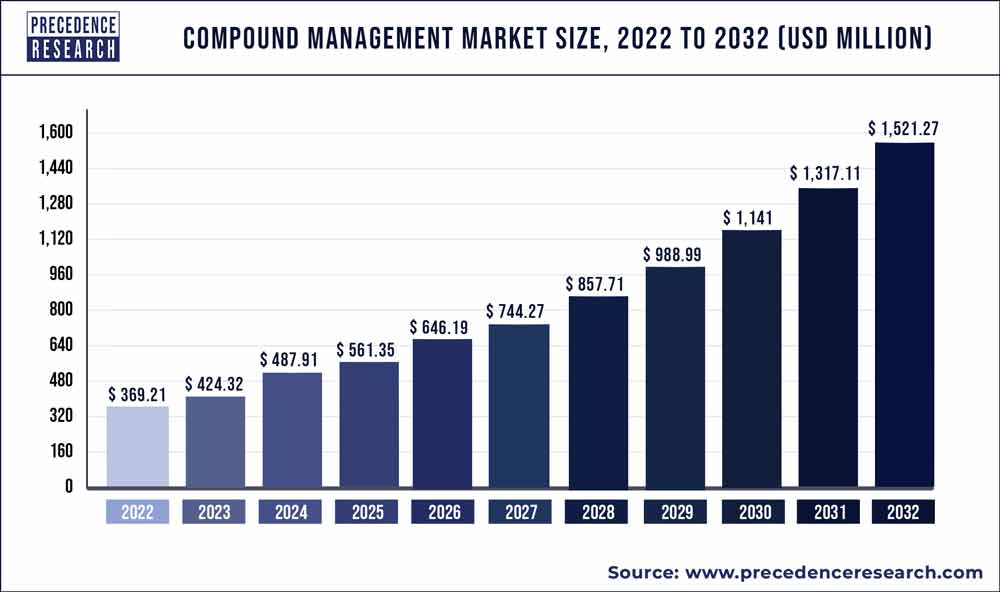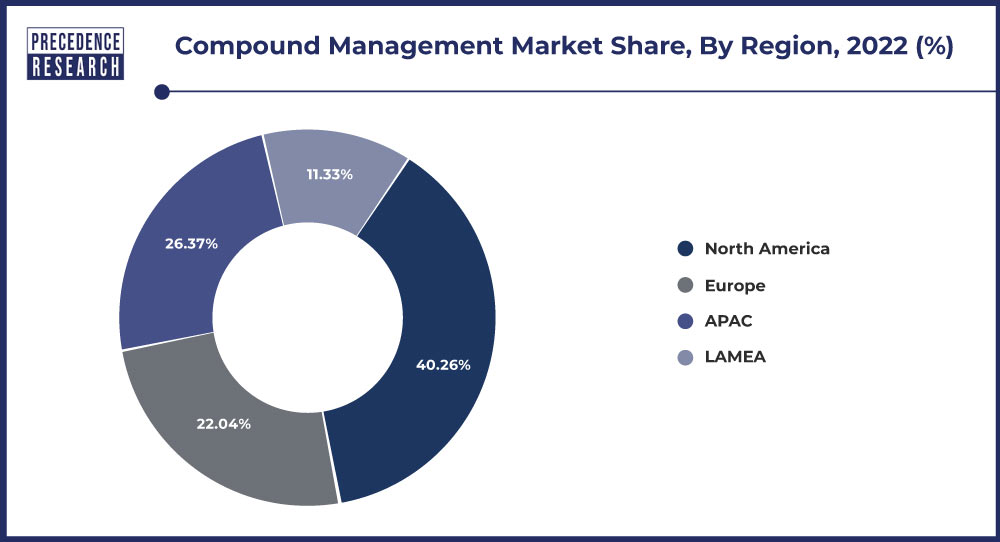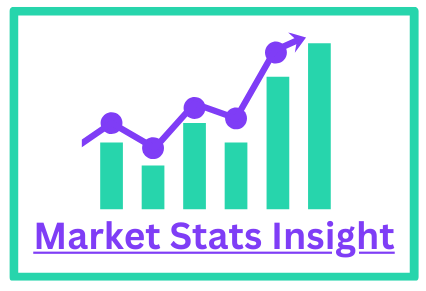The global compound management market size reached USD 369.2 million in 2022 and is projected to hit around USD 1,521.27 million by 2032, expanding at a CAGR of 15.2% from 2023 to 2032.

Compound Management Market Key Pointers
- In 2022, the products segment’s revenue share was 60.64%.
- The service sector will grow between 2023 and 2032 at a 14.9% compound annual growth rate.
- In 2022, the chemical compounds category accounted for approximately 53.68% of total revenue.
- Forecasted growth for the biosamples segment is a 15.6% compound annual growth rate (CAGR) from 2023 to 2032.
- In 2022, the pharmaceutical businesses segment accounted for 34.86% of total revenue.
- The CAGR for the biopharmaceutical businesses segment is anticipated to be 15.5%.
Get a Sample: https://www.precedenceresearch.com/sample/2466
Compound Management Market Regional Stance
Based on geographical analysis, the global compound management market is divided into four main regions: North America, Europe, Asia Pacific, and LAMEA. Given North America’s substantial consumer base and leading GDP, it’s projected to assert dominance in this market. Currently, North America holds the lion’s share, approximately 40.26%, of the compound management market revenue. This is attributed to several factors such as the increasing outsourcing of compound management services, the integration of artificial intelligence (AI) in drug development processes, and the prevalent trend of biobanking.

The region is witnessing a surge in research and development (R&D) activities within the pharmaceutical and biotechnology sectors. As a result, Europe is anticipated to experience the highest growth rate in the compound management market. Meanwhile, the Middle East and Africa are also expected to witness significant growth during the forecast period, primarily driven by the rising adoption of biobanking practices and the implementation of software upgrades.
In terms of specific market figures, the compound management market size in North America was valued at $148.64 million in 2022, with projections suggesting it will reach approximately $594.29 million by 2032. Similarly, Europe’s compound management market size was estimated at $81.39 million in 2022 and is anticipated to exceed $338.72 million by 2032.
Related Report: Pharma 4.0 Market Size Projected to Reach USD 63.29 Billion By 2032
Compound Management Market Trends
- Automation and Robotics Integration: This trend involves incorporating automation and robotics into compound management processes. These technologies help streamline tasks like handling, storing, and retrieving samples. By reducing the need for manual intervention, they minimize human error and boost productivity in compound management workflows.
- Advanced Sample Tracking Solutions: Innovations like RFID and barcode systems are increasingly being used for tracking samples in real-time throughout the compound management process. These solutions enhance traceability, making it easier to monitor samples and reducing the risk of misplacement or loss.
- Growing Outsourcing of Compound Management Services: More pharmaceutical and biotech companies are choosing to outsource their compound management needs to specialized service providers. By doing so, these organizations can take advantage of the expertise and infrastructure offered by third-party providers, leading to cost savings and allowing internal resources to focus on core activities.
- Rise of Cloud-Based Compound Management Platforms: Cloud-based software solutions are gaining popularity in the compound management market due to their scalability, flexibility, and accessibility. These platforms provide features like inventory management, sample tracking, and data analysis, enabling efficient management of compound libraries across multiple locations.
- Focus on Data Integration and Analysis: There’s a growing emphasis on integrating compound management data with other systems used in research and development, such as LIMS and ELNs. This integration facilitates data sharing, collaboration, and advanced analytics, ultimately driving insights for drug discovery and development processes.
Compound Management Market Dynamics
Driver
The increasing Research and Development (R&D) activities serve as a significant market driver for the compound management market. As pharmaceutical, biotechnology, and academic research organizations intensify their efforts to discover and develop novel therapeutics, there is a growing demand for efficient compound management solutions. These solutions play a crucial role in the storage, retrieval, tracking, and distribution of chemical compounds and biological samples used in drug discovery and development processes. With advancements in high-throughput screening technologies, automation, and data management systems, compound management providers are innovating to meet the evolving needs of researchers for improved efficiency, accuracy, and scalability.
Moreover, as the complexity of drug discovery pipelines increases and regulatory requirements become more stringent, there is a heightened focus on ensuring the integrity and traceability of compound libraries. This trend underscores the importance of investing in robust compound management infrastructure and services to support R&D activities, accelerate drug discovery workflows, and drive innovation in the pharmaceutical and biotechnology industries.
Restraint
The compound management market faces a notable challenge due to the high initial investment required to establish comprehensive compound management systems. Compound management involves the storage, tracking, and distribution of chemical compounds used in drug discovery and development, necessitating specialized infrastructure, automation equipment, and information management systems. The costs associated with acquiring and implementing such systems, including laboratory automation platforms, compound libraries, and inventory management software, can be substantial, particularly for research institutions, pharmaceutical companies, and contract research organizations (CROs) with limited budgets.
Moreover, ongoing maintenance, staff training, and regulatory compliance further add to the initial investment burden. These high upfront costs may deter organizations from investing in robust compound management solutions, leading to inefficiencies, errors, and delays in drug discovery workflows. Addressing the high initial investment of the compound management market requires strategic planning, budget allocation, and consideration of cost-effective solutions such as outsourcing compound management services or adopting modular, scalable systems that allow for incremental expansion. By overcoming financial barriers, stakeholders can enhance operational efficiency, accelerate drug discovery processes, and ultimately improve the success rates of pharmaceutical research and development endeavors.
Opportunity
The increased outsourcing of compound management is reshaping the landscape of the compound management market, offering pharmaceutical and biotechnology companies greater flexibility, efficiency, and cost-effectiveness in drug discovery and development processes. Outsourcing compound management services allows companies to leverage specialized expertise, state-of-the-art facilities, and scalable infrastructure without the need for substantial upfront investments. Service providers offer comprehensive solutions for the storage, handling, tracking, and distribution of compound libraries, enabling clients to streamline their workflows, accelerate research timelines, and focus resources on core competencies.
Additionally, outsourcing compound management minimizes operational risks, ensures compliance with regulatory standards, and facilitates access to a broader range of screening assays and research tools. As the demand for innovative drug candidates continues to grow, outsourcing compound management emerges as a strategic approach for pharmaceutical and biotechnology companies to enhance their research capabilities and maintain a competitive edge in the dynamic healthcare landscape.
Compound Management Market By Type:
- Products vs. Services: The market is segmented into products and services.
- Revenue Share: In 2022, the product segment generated the highest revenue share.
- Projected Growth: The product segment is expected to grow at a CAGR of 15.5% from 2023 to 2032, while the services segment is projected to grow at a CAGR of 14.9% over the same period.
Compound Management Market By Sample Type:
- Chemical Compounds vs. Bio Samples: Segmented into chemical compounds and bio samples.
- Dominance of Chemical Compounds: Chemical compounds, especially biopharmaceuticals, dominated the market in 2022, accounting for over 53.68% of revenue share.
- Reasons for Dominance: Chemical compounds are extensively used in drug discovery processes, both as reagents and in reactions.
- Projected Growth: Both chemical compounds and bio samples are expected to show significant growth in revenue from 2022 to 2032.
Compound Management Market By End User:
- Segmentation: End users are segmented into Biopharma Companies, Biobanks, Pharma Companies, and CROs.
- High Growth in Biopharma Companies: Biopharma companies are expected to exhibit the highest CAGR over the forecast period, driven by factors such as increased biologic manufacturing and R&D expenditures.
- Biobanking Growth: The biobanking segment is expected to grow at a lucrative CAGR, fueled by the rising focus on personalized medicine and increased demand for biospecimens.
- Overall Growth: All end user segments are projected to experience substantial revenue growth from 2022 to 2032.
Leading Companies in the Compound Management Market
- Brooks Automation (US)
- Hamilton Company (US)
- TTP Group (US)
- Labcyte (US)
- Biosero (US)
- SPT Labtech LTD.
- Tecan Trading AG
- LiCONiC AG
- Titian Service Limited
- Wuxi Apptec
- Evotec
Segments Covered in the Report
By Type
- Products
- Services
By Sample Type
- Chemical Compounds
- Bio Samples
By End-User
- Biopharma Companies,
- Biobank
- Pharma Companies
- CRO
By Geography
- North America
- Europe
- Asia-Pacific
- Latin America
- Middle East & Africa (MEA)
Immediate Delivery Available | Buy This Premium Research Report@ https://www.precedenceresearch.com/checkout/2466
